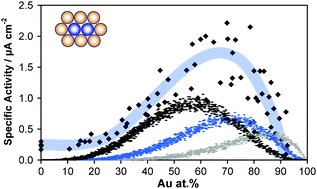The hydrogen evolution reaction and hydrogenoxidation reaction on thin film PdAu alloy surfaces
Abstract
A high throughput synthetic and screening methodology has been applied to the study of the

* Corresponding authors
a
School of Chemistry, The University of Southampton, Southampton SO17 1BJ, UK
E-mail:
beh@soton.ac.uk
A high throughput synthetic and screening methodology has been applied to the study of the

 Please wait while we load your content...
Something went wrong. Try again?
Please wait while we load your content...
Something went wrong. Try again?
F. A. Al-Odail, A. Anastasopoulos and B. E. Hayden, Phys. Chem. Chem. Phys., 2010, 12, 11398 DOI: 10.1039/B924656H
To request permission to reproduce material from this article, please go to the Copyright Clearance Center request page.
If you are an author contributing to an RSC publication, you do not need to request permission provided correct acknowledgement is given.
If you are the author of this article, you do not need to request permission to reproduce figures and diagrams provided correct acknowledgement is given. If you want to reproduce the whole article in a third-party publication (excluding your thesis/dissertation for which permission is not required) please go to the Copyright Clearance Center request page.
Read more about how to correctly acknowledge RSC content.
 Fetching data from CrossRef.
Fetching data from CrossRef.
This may take some time to load.
Loading related content
